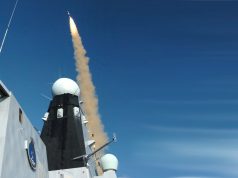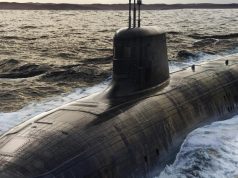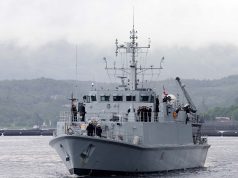Following the example of the US Navy, which recently set up an unmanned task force in the Middle East, the UK Royal Navy has deployed an unmanned boat to the Persian Gulf for hot climate trials.
Royal Navy motor boat ‘Harrier’ is part of a ten-year program for replacing the Navy’s current fleet of mine counter measure vessels and her time in the region will lay the foundation for future autonomous kit.
While deployed for operations, the 11-meter boat will work with host ship RFA Cardigan Bay to conduct a series of demonstrations and trials that will prove her ability to operate in the harsh and demanding weather conditions of the Gulf.
The UK boat will be joining unmanned systems operated by the US Navy in the region as part of Task Force 59, a task force operating a range of unmanned systems operating out of Bahrain since September 2021.
Harrier is capable of operating both autonomously (pre-programmed to conduct a mission) or remotely from a ship or shore-based remote control centre. She tows a side-scan sonar behind her to look for mines on the seabed, alerting units ashore or at sea of their whereabouts. In the future, she will also work with remotely operated underwater vehicles and a mine sweeping system.
The tests will be key for seeing how the remote-controlled mine sweeper deals with hot climates, having already proved her ability in UK waters. She will face water temperatures of more than 30C in the summer, very different from her previous home of Faslane.
Harrier will be put through her paces on integrating with Royal Navy personnel and units in the region – mine counter measure battlestaff, the UK’s naval support facility in Bahrain and countries who work with the UK, protecting shipping and the freedom of navigation.
Harrier will provide another arrow in the quiver of the mine countermeasures commander and her success will be a stepping-stone for complimentary autonomous kit coming available in the near future.
Lieutenant Commander Mark Shaw, commanding officer of Mission System Team One in the Mine Threat Exploitation Group, said: “We are excited to be involved in the mine hunting capability program which will transition the Royal Navy from a ship-based mine counter measures (MCM) capability to maritime autonomous off-board systems.
“Our task is to prove this first iteration of the capability in an operational environment.
“This is a step change in the way the Royal Navy conducts MCM, and we are not just proving the equipment and operating procedures but setting the template on how we operate and integrate within the wider force.
A move towards autonomous mine-hunting will enable the Royal Navy to counter the evolving threat of modern sea mines while reducing the risk to sailors.



























